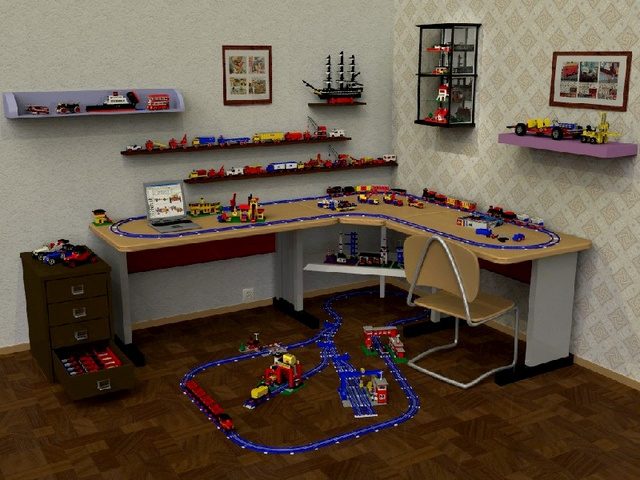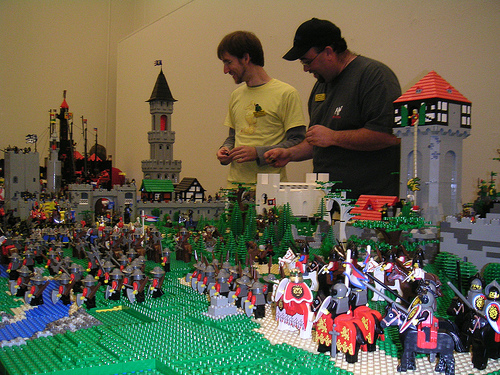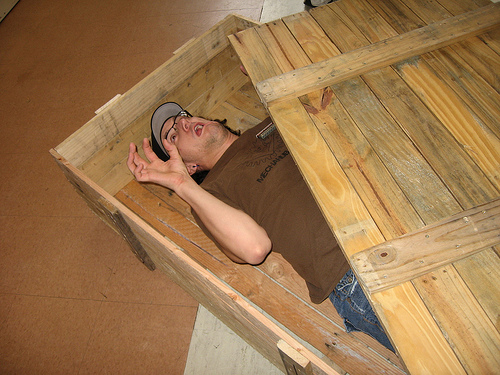The Eggplant Wizard cooks up a party inside this giant castle on Eggplant Island. The dynamic features such as the towers and arches are an instant hit, and the view from top is nothing short of beautiful. But from that upfront sign hanging over the cliff, you know this is the place where a valiant knight is reflected in the number of rounds he can down. Let’s party!
Yearly Archives: 2008
LDraw – the original LEGO CAD
 One of my side-interests (originally my main interest) in LEGO is CAD or virtual building using the LDraw system first created by the late James Jessiman. When you have a small collection of parts it is a great way to ‘build’ models that live up to your imagination rather than being limited to your supply. LDD provides one means of creating virtual LEGO models but if you take the time to learn it the older LDraw provides a much wider pallette of parts and more powerful tools than LDD. Best of all the two programs can share files with a bit of tweaking.
One of my side-interests (originally my main interest) in LEGO is CAD or virtual building using the LDraw system first created by the late James Jessiman. When you have a small collection of parts it is a great way to ‘build’ models that live up to your imagination rather than being limited to your supply. LDD provides one means of creating virtual LEGO models but if you take the time to learn it the older LDraw provides a much wider pallette of parts and more powerful tools than LDD. Best of all the two programs can share files with a bit of tweaking.
I realised today that many TBB readers may not be familiar with LDraw so I thought I’d take a brief moment to promote it. Most discussions takes place on LUGNET but to make things more accessible I created a Facebook group and Flickr group too. Hopefully I’ll see some fresh faces at one of these places. The LDraw website (and organisation) organise regular challenges and contests too so be sure to check them out.
NB. The image above is by Jan Folkersma and is the winner of the LDraw Scene of the Month contest from January 2007
Two scenes by Sir Nadroj
We feature two unique dioramas by the ever so prolific Jordan Schwartz, depicting a Victorian-esque sci-fi laboratory, which serves as the backdrop in the first part of Jordan’s fiction story called Journey to the Center of the Earth. The working lights on this creation are purchased from Lifelites.
Next is a creation called Bar of the Future, featurng a crowd of whimsical bar aliens.

Registration now open for BrickCon 2008, October 2-5 in Seattle [News]
If you’ve never been to a LEGO convention, you probably don’t know what you’re missing. Even if you’ve seen thousands of pictures, it’s not the same.
BrickCon is my hometown LEGO con, held each October in Seattle. Registration is now open, and I’d highly recommend signing up today to come to our fair city this fall.
Naturally, the big draw at any LEGO con is all the LEGO! You might see creations like Kevin Blocksidge’s “Victorian Floating Rock” or a War of the Worlds tripod by Lino Martins:
Maybe you prefer Town creations, like “The Real Cafe Corner” by Alice Leber-Cook, or huge Castle battles:
Of course, BrickCon isn’t just about LEGO. Where else can you have your picture taken with Josh, Shannon, Brendan, a dude in a kilt, Robin, John, and The Keith?
And don’t forget the adoring fans (that’s the back of Michael Rutherford’s head):
Oh, there’s also free stuff. Here’s Steve Barile winning 10181 Eiffel Tower:
When the con is done, here’s how we ship Nathan Proudlove back to Manitoba:
If you’re still not convinced, you might want to check out our past coverage here on The Brothers Brick:
- BrickCon 2007 Day 3 Report
- BrickCon 2007 Day 2 Report
- BrickCon 2007 Day 1 Report
- BrickCon 2006 coverage summary
So, what are you waiting for? Register today!
Gorazd Vahen patrols the desert
Gorazd Vahen‘s “fist vig” features a very cool little vehicle:
Also check out the Jeep in dark grey:
I’m always impressed when somebody has the patience to rebuild one of their creations in an alternate color scheme.
More than the sum of its parts
A mecha collaboration project that draws together three of the best Japanese mecha builders, the so-called LEGO Robo Session (LRS) teams up Izzo (Brickshelf), Kwi Chang (Brickshelf), and Moko (Brickshelf), with each builder building parts of a mecha. The parts are then combined into something incredible. Here’s round two of the project, which lasted from November 2007 to now. You can see their first mecha here.

For this session, Moko contributed 3 components (the body, backpack, and gun), Kwi Chang also provided 3 (the cockpit, head, and right hand), while Izzo built 4 components (cannon, left hand, legs, and waist) and assembled the completed mecha.
Via YSA.
Triumphant Samurai
Tyler’s (Legohaulic) fantasy samurai stands gracefully poised while clutching the head of a slayed monster. Inspired by this artwork, Tyler captures the victorious pose and the dazzling fantasy elements and depicts them all in this sculpture.

RAILBRICKS Issue 3
 RAILBRICKS magazine hits its third issue this week with tips, reviews and ideas for all LEGO train fans. To quote the release the issue features
RAILBRICKS magazine hits its third issue this week with tips, reviews and ideas for all LEGO train fans. To quote the release the issue features
• PF Trains + 9v Train Tricks
• Creating Wooden Trestle Bridges
• RCX (PBricks) and 9v Train Integration
• Interview with Swoofty
• and much more…..
and having looked through it I’d have to agree. It’s a top notch publication so Jeramy Spurgeon and the rest of the editing team deserve much kudos. Check it out.
Available from: Mirror 1, Mirror 2 and a Lulu print version
Lego is communication: summing up

Over the last six weeks, we’ve been on a fun ride. Through a series of posts we’ve been exploring our chosen medium from a communicational point of view. In case you missed it, here are links to the other instalments:
0. Introduction
1. Context: the message
2. Context: the audience
3. Tools: Design & build, with case study #1
3b. Case study #2
3c. Case study #3
4. Tools: Presentation
5. Other
6. Summing up
I’ve argued that all LEGO models can be considered messages (post #1) to an audience (post #2), designed (post #3) and presented (post #4) in a way that enhances or dehances the models’ effect. Deathdog exemplifies this brilliantly in a comment on post #1. His creation was bashed at Classic-Castle. To Deathdog, the people there misinterpreted his model – which really just means that they interpreted it differently than he did. Not wrongly. Time to either a) appeal to a different crowd, or b) create the next model so that they interpret it the same way he does. (The hidden alternative c) “educate” the existing audience is not only rather time consuming, but also ethically dubious.)
Analyzing your own builds like this, and the builds of others, help uncover flaws they might have. But remember, as I wrote in the disclaimer (post #5) – following this “guide” like a mindless drone will only result in good models. To create the great ones you have to add your own kind of magic. I’ve just preached for one way of thinking that could help you hammer out your build better.
It’s a way of thinking professionals have been using for ages – successfully, even – but that doesn’t mean it’s perfect.
Before I started to actually write this series I sat down and thought about what I wanted to achieve with it all. I divided the readers of this blog into three categories:
- Active builders
- “Sleeping” builders
- The interested public
I assigned each of these groups one core effect I wanted to achieve, and ranked their order of importance. The things I learned from doing this let me decide how to present the thoughts. From least important to most important (you might be surprised):
3. “Sleeping builders”
Sleeping builders are those who might become a LEGO builder, but perhaps don’t realize it yet. I wanted to, with luck, wake some of you up. The Brothers Brick showcases a lot of nice models every week, and that combined with some food for thought can make for an interesting stimuli. I cannot describe the joy I felt when Alan R wrote:
Hey,
I’d just like to thank you for this series, and this blog in general.
From when I was around 5 until about 2 years ago (when I was 14) I played with LEGO non-stop, but then for whatever reason, I fell out of love with it, and took a long hiatus. However, thanks to (for a large part) this blog, I recently restarted my building, and am really happy to have done so (especially with 3 months of summer looming ahead).
I just recently finished an approximately to scale LCVP (WWII Landing craft, think D-Day), in a large part due to this series’ ideas of “message/ audience/ build”
As my audience is mainly me (but showing off to my friends b/c i’m proud of my work), I dunno if I’ll set up a flickr acct / MOCPages acct and share it with the world, but that’s not the point. Thanks in a large part to this blog, and especially this series, I went from vaguely thinking about LEGO once-a-month to actually getting back into the thick of it, and I’m really happy to have done so.
Thanks
Thanks for writing that, Alan. The best of luck to you in your LEGO endeavours. Don’t hesitate to let us know about the things you’ve built in the future, if you feel so inclined.
2. Active builders
Those that are already “in the thick of it” are active builders. I wanted to show you a new way to think about your models, away from all techniques, greebling, SNOT, studlessness, (and SNOTlessness!) and whatnot. I wanted you to see a bigger picture and get you to understand that if you want to, you really can do whatever with the medium.
It is you who have been most active in the discussions, as expected. You’ve questioned me, agreed with me, helped me twist and turn the arguments, and reminded me of things I forgot. In the end you made me think, both as a builder and as a communicator. Just how I like it. Thank you for that. I hope I made you think as well.
1. Interested public
Paradoxically, the people I considered the most important to reach are also the ones most likely to scroll past these posts: the interested public that mainly comes to see the fantastic models featured on TBB. This group constitute the bulk of our readers. What I wanted to show these people was that while LEGO is a toy, it is also a serious medium for expression. Even though most of you in this group don’t read these posts as carefully as the other two groups, just knowing that serious discussion is being held make you perceive LEGO differently – if only at a subconscious level. And nothing says intelligent discussion like lengthy written ramblings.
Now I’d like to your input again. This type of post was a first for The Brothers Brick. If I have my way it was the first of many meta-theoretical posts, but it was also a way for me to establish a framework in which I could post more concrete tips on building, presentation and much more on a regular basis. Tell me: do these kinds of posts belong on this blog? Why? Why not? What would you like to see discussed in the future?
Thank you for reading this far.
Fighting off infection
Izzo’s Navy Impulse
The shape of Izzo’s latest mecha is highly unusual, with a pointed “nose” and tons of wings:
Looking beyond the obvious, note the use of snowshoes in the backpack/engine! More on Brickshelf.
Spinnenartiges Tier by Scotty Whitesell
Scotty Whitesell‘s builds just keep getting better and better.
The leg design on Scotty’s “Spinnenartiges Tier” use motorcycle bodies in a completely unique way:
Here’s a bonus Scotty-bot — an automated loading robot dubbed, appropriately enough, “Longshoreman”:















